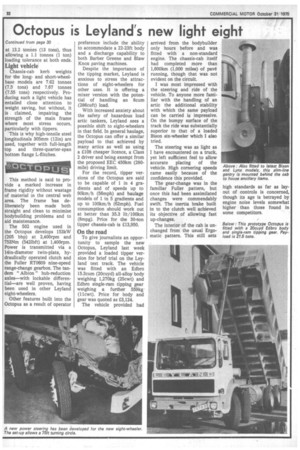This method is said to provide a marked increase in
Page 34

If you've noticed an error in this article please click here to report it so we can fix it.
frame rigidity without wastage of material in the central web area. The frame has deliberately been made both straight and clean to minimise bodybuilding problems and to aid maintenance.
The 502 engine used in the Octopus develops 153kW (205 bhp) at 2,400rpm and 753Nm (5421bft) at 1,400rpm. Power is transmitted via a 14in-diameter twin-plate, hydraulically operated clutch and the Fuller RT0609 nine-speed range-change gearbox. The tandem " Albion " hub-reduction axles—with lockable differential—are well proven, having been used in other Leyland eight-wheelers.
Other features built into the Octopus as a result of operator preference include the ability to accommodate a 22-23ft body and a discharge capability to both Barber Greene and Blaw Knox paving machines.
Despite the importance of the tipping market, Leyland is anxious to stress the attractions of eight-wheelers for other uses. It is offering a mixer version with the potential of handling an 8cum (286cuft) load.
With increased anxiety about the safety of hazardous load artic tankers, Leyland sees a possible shift to eight-wheelers in that field. In general haulage, the Octopus can offer a similar payload to that achieved by many artics as well as using a £108 cheaper licence, a Class 2 driver and being exempt from the proposed EEC 450km (280mile) driving limit.
For the record, tipper versions of the Octopus are said to be capable of 1 in 4 gradients and of speeds up to 90km/h (56mph) and haulage models of 1 in 5 gradients and up to 100km/h (62mph). Fuel consumption should work out at better than 35.3 lit/100km (8mpg). Price for the 30-ton tipper chassis-cab is £13,950.
On the road
To give journalists an opportunity to sample the new Octopus, Leyland last week provided a loaded tipper version for brief trial on the Leyland test track. The vehicle was fitted with an Edbro 15.3cum (20cuyd) all-alloy body weighing 1,270kg (25cwt) and Edbro single-ram tipping gear weighing a further 559kg (11cwt). Price for body and gear was quoted as £3,124.
The vehicle provided had arrived from the bodybuilder only hours before and was fitted with a non-standard engine. The chassis-cab itself had completed more than 1,600km (1,000 miles) of pave running, though that was not evident on the circuit.
I was most impressed with the steering and ride of the vehicle. To anyone more familiar with the handling of an artic the additional stability with which the same payload can be carried is impressive. On the bumpy surface of the track the ride was substantially superior to that of a loaded Bison six-wheeler which I also tried.
The steering was as light as I have encountered on a truck, yet left sufficient feel to allow accurate placing of the vehicle. High cornering speeds came easily because of the confidence this provided.
The gear-change was in the familiar Fuller pattern, but once this had been assimilated changes were commendably swift. The inertia brake built in to the clutch well achieved its objective of allowing fast up-changes.
The interior of the cab is unchanged from the usual Ergomatic pattern. This still sets high standards as far as layout of controls is concerned, though its age is betrayed by engine noise levels somewhat higher than those found in some competitors.
































































































